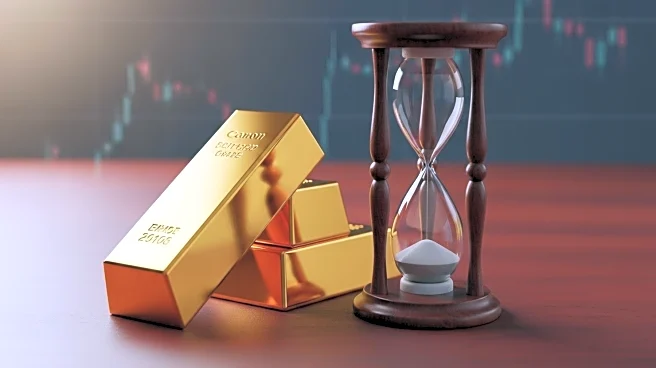What's Happening?
The U.S. Federal Reserve recently cut its policy rate, a decision fully supported by San Francisco Federal Reserve Bank President Mary Daly. This move is anticipated to lead to further rate reductions, with market participants expecting two more 25-basis-point cuts in October and December. The rate cuts have contributed to a bullish performance in gold prices, which reached a record high of $3,790.82 per ounce earlier this week. The U.S. dollar index fell slightly, making gold less expensive for overseas buyers. Investors are closely monitoring upcoming U.S. economic data, including the personal consumption expenditures price index report, for further insights into Federal Reserve policy decisions.
Why It's Important?
The Federal Reserve's decision to cut rates is significant as it reflects a shift in focus towards supporting the labor market amidst inflation concerns. Lower interest rates typically benefit safe-haven assets like gold, which has seen a surge in prices. This environment could lead to increased investment in gold, impacting financial markets and investor strategies. The anticipated rate cuts may also influence borrowing costs, consumer spending, and overall economic growth. Stakeholders such as investors, businesses, and policymakers are closely watching these developments to adjust their strategies accordingly.
What's Next?
Investors are awaiting the release of the personal consumption expenditures price index report, which is the Federal Reserve's preferred measure of inflation. This report, expected to show a modest rise, could provide further cues on interest rate decisions. Additionally, weekly U.S. jobless claims data will offer insights into labor market conditions. The Federal Reserve's future actions will likely depend on these economic indicators, with potential implications for monetary policy and market dynamics.
Beyond the Headlines
The Federal Reserve's rate cuts and the subsequent impact on gold prices highlight broader economic trends, including the balancing act between inflation control and labor market support. This situation underscores the complexities of monetary policy in a fluctuating economic environment. The focus on maintaining economic stability while addressing inflation risks may lead to long-term shifts in investment strategies and economic growth patterns.











